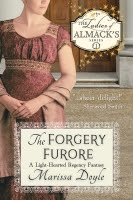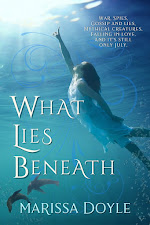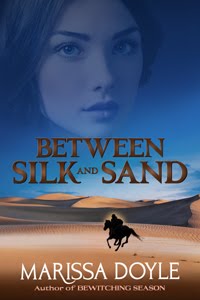 So here we are at the Romance Writers of America conference. It’s a little like the Season, when all young ladies of good family went to London or another large town and were formally presented to the rest of Society. Marissa and I have been making polite conversation with editors, agents, our writing colleagues, and other industry professionals just like nineteenth century ladies made calls. We were invited to tea with some of the luminaries of our circle (God bless you, John). As you saw in Marissa’s post, we attended a lovely Soiree on Wednesday. And last night, Marissa termed the Harlequin Party a sad crush (which is nineteenth-century speak for a very popular event). Alas, there were no dukes or princes present, but that didn’t stop us from dancing. Or posing.
So here we are at the Romance Writers of America conference. It’s a little like the Season, when all young ladies of good family went to London or another large town and were formally presented to the rest of Society. Marissa and I have been making polite conversation with editors, agents, our writing colleagues, and other industry professionals just like nineteenth century ladies made calls. We were invited to tea with some of the luminaries of our circle (God bless you, John). As you saw in Marissa’s post, we attended a lovely Soiree on Wednesday. And last night, Marissa termed the Harlequin Party a sad crush (which is nineteenth-century speak for a very popular event). Alas, there were no dukes or princes present, but that didn’t stop us from dancing. Or posing.Tonight is the grand finale, the big night for romance. The Rita Awards, the equivalent of the Academy Awards for the romance community, will be given out. We’ll dress up in our finest gowns and wait breathlessly for the names of friends and favorite authors to be announced. It’s a little like waiting to be presented to the queen.
But we don’t have to wait to hear about our own personal winner. You see, the Rita isn’t the only award given at conference. The mystery and romantic suspense authors present the Daphne Du Maurier for best romantic suspense novels. The Greater Detroit Romance Writers give away their Bookseller’s Best Award for novels in various categories judged best by booksellers. The Futuristic, Fantasy, and Paranormal group gives awards for the best in that area. The Oklahoma Chapter runs a competition for best book as judged by readers around the nation.
 I am honored to announce that our own Marissa Doyle was awarded the National Reader’s Choice Award. Betraying Season won for best young adult novel for 2009. I was so proud, I carried her rock all the way back to our hotel room. Well, okay, I carried it part of the way before she relieved me of it. I think she saw the possessive gleam in my eyes.
I am honored to announce that our own Marissa Doyle was awarded the National Reader’s Choice Award. Betraying Season won for best young adult novel for 2009. I was so proud, I carried her rock all the way back to our hotel room. Well, okay, I carried it part of the way before she relieved me of it. I think she saw the possessive gleam in my eyes. Can we all brag that we know her?

























